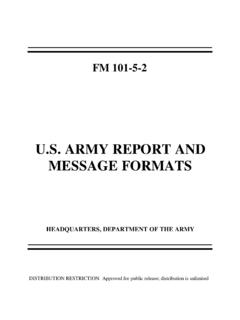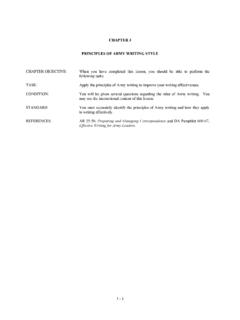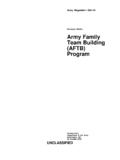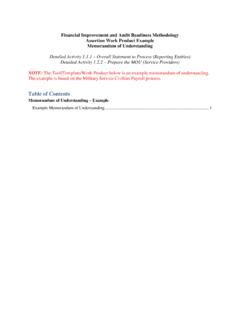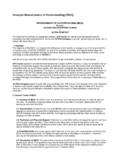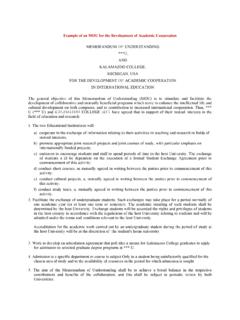Transcription of CHAPTER 5 SOME SPECIFIC GUIDANCE ON ARMY …
1 CHAPTER 5. some SPECIFIC GUIDANCE ON army CORRESPONDENCE. CHAPTER OBJECTIVE: When you have completed this lesson, you should be able to perform the following task. TASK: Name and define the parts of a memorandum , the staff study and the decision paper. CONDITION: Given several questions relative to a review of the staff study and decision paper, and their parts and purpose. You may use Lesson 5, some SPECIFIC GUIDANCE on army Correspondence, which explains these concepts. STANDARD: Identify the basic parts of a staff study and a decision paper and their purposes in army correspondence.
2 REFERENCES: AR 25-50, Preparing and Managing Correspondence and DA Pamphlet 600-67, Effective Writing for army Leaders. 5-1. CHAPTER 5. some SPECIFIC GUIDANCE ON army CORRESPONDENCE. 1. INTRODUCTION. army Regulation 25-50, Preparing and Managing Correspondence, gives SPECIFIC GUIDANCE on the many correspondence formats used by the army . In this lesson we will review the informal memorandum , the staff study, and the decision paper. 2. MEMORANDUMS. a. The basic format for army correspondence is the formal memorandum . It is used to correspond formally (internally and externally) with any command, staff, or activity within the Department of Defense.
3 B. You can modify the basic format to create the various other types of memorandums used in the Department of the army . However, critical reasoning, creative thinking, the five steps of effective writing, and elements of style are common to all memorandums. Three common modifications are the Informal memorandum , memorandum for Record, and memorandum of Agreement (or understanding ). (1) The Informal memorandum . Commands use the informal memorandum to communicate informally within a unit, organization, or agency. Its format is the same as the formal memorandum , except that you do not use letterhead stationery.
4 (2) The memorandum for Record. The purpose of the memorandum for Record (MFR) is to document conversations, meetings, and other events for future reference. Its format is the same as the informal memorandum , except the word "RECORD" appears in the place of the addressee. (3) The memorandum of Agreement (or understanding ). The memorandum of Agreement (or the memorandum of understanding ) is to document agreements or understandings. The format is the same as the memorandum except for two changes. First the phrase " memorandum OF AGREEMENT" or " memorandum .
5 OF understanding " appears on the second line below the seal. Second, a signature block appears for each party entering into the agreement or understanding . c. Format rules for a memorandum . (1) The Heading. (a) Use letterhead stationery for the first page only. If not available, use plain white paper. (b) Put the suspense date at the right margin on the same line as the Reply to Attention Of or one clear space above the date of the memorandum . (c) List the office symbol of the originating office or unit flush left two lines below the seal, three lines above the memorandum FOR line.
6 (d) In parenthesis two spaces after the office symbol add a Modern army Recordkeeping System (MARKS) number. This number indicates where to file the document. (e) Type the date of signature flush right on the same line as the office symbol. Use military dates in memorandums. For example: 23 June 1999. If you abbreviate the month use upper and lower case letters and also abbreviate the year. For example: 23 Jun 99. 5-2. (f) Three lines below the office symbol line and beginning at the left margin type memorandum FOR followed by the address line.
7 If the address line extends to a second line, indent the second line to start under the third letter of the word after FOR. For example: memorandum FOR Commander, Combined Arms Center and Fort Leavenworth, Fort Leavenworth, KS 66027. (g) Type SUBJECT: flush left on the second line below memorandum FOR. Skip two spaces and begin typing your subject. Identify your subject clearly. Use a noun phrase. (2) The Body. (a) Begin the first paragraph on the third line below the subject line. (b) Maintain 1-inch margins all around. (c) Single-space the text, and double-space between paragraphs.
8 (d) Acronyms, abbreviations, and brevity codes. 1. Use only those acronyms, abbreviations, and brevity codes your reader will understand. The first time an acronym is used in a document, spell it out and follow it with the acronym in parenthesis. 2. Type acronyms in upper case letters without periods. Don't use apostrophes to form the plurals. (e) Separate each major section by using numbered paragraphs and lettered or numbered subparagraphs with clear headers. All major sections begin at the left margin. (f) Subparagraphs. 1. Indent all first level subparagraphs four spaces and begin typing on the fifth space.
9 Indent second level subparagraphs eight spaces. Wrap all second and succeeding lines to the left margin. 2. If you create an "a" subparagraph, you must also have at least a "b". subparagraph. If you have a "(1)," you must also have a "(2)." Do not subdivide paragraphs beyond the third subdivision; however, do not indent any further than the second subdivision. (g) Continuation pages. 1. Put the office symbol at the left margin on line eight of each continuation page. Do not type the date. 2. Type the subject line (worded exactly as on page 1) on the line immediately following the office symbol (don't skip a line).
10 3. Center the page number 1 inch from the bottom of the page starting with page 2. (3) Point of contact. If you have a point of contact (POC), list the rank, name, office, and telephone number in the last paragraph. (4) Authority line. Use an authority line (FOR THE COMMANDER, FOR THE DIRECTOR, etc.) if applicable. The authority line is flush left on the second line below the last paragraph. 5-3. (5) Signature block. Type the signature block on the fifth line below the last paragraph or the authority line (if included). The signature block starts at the center of the page.



